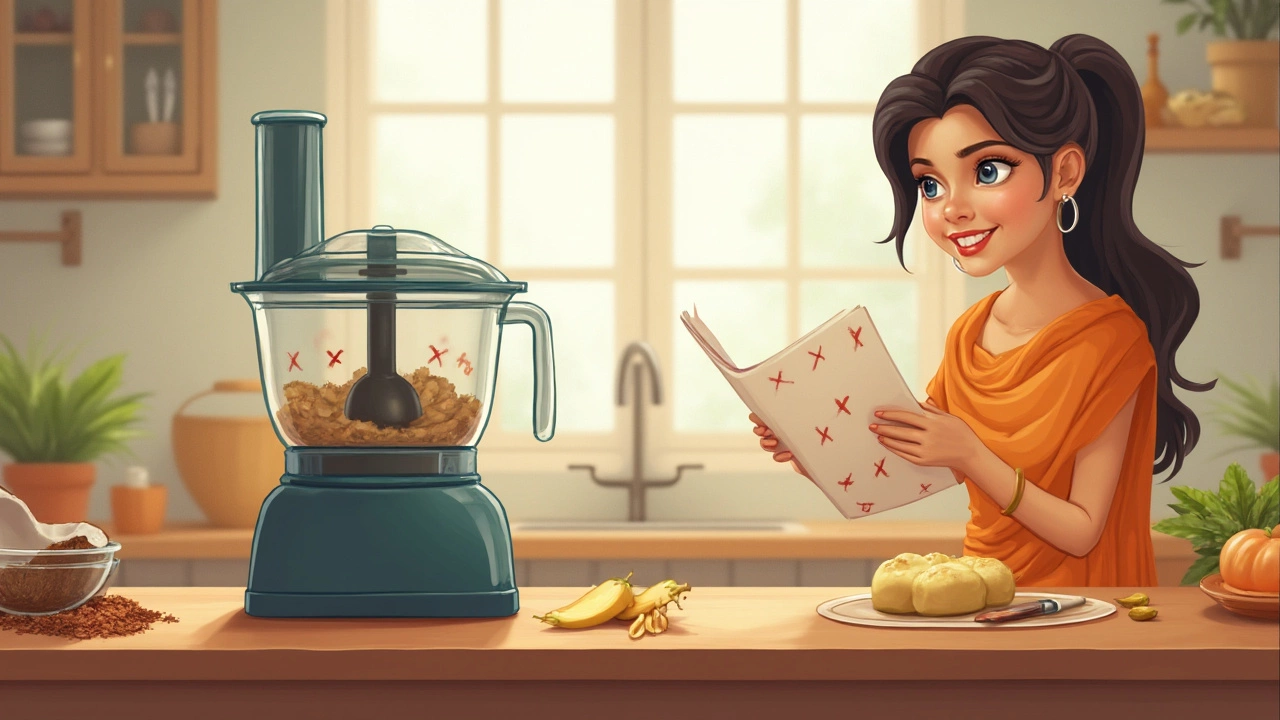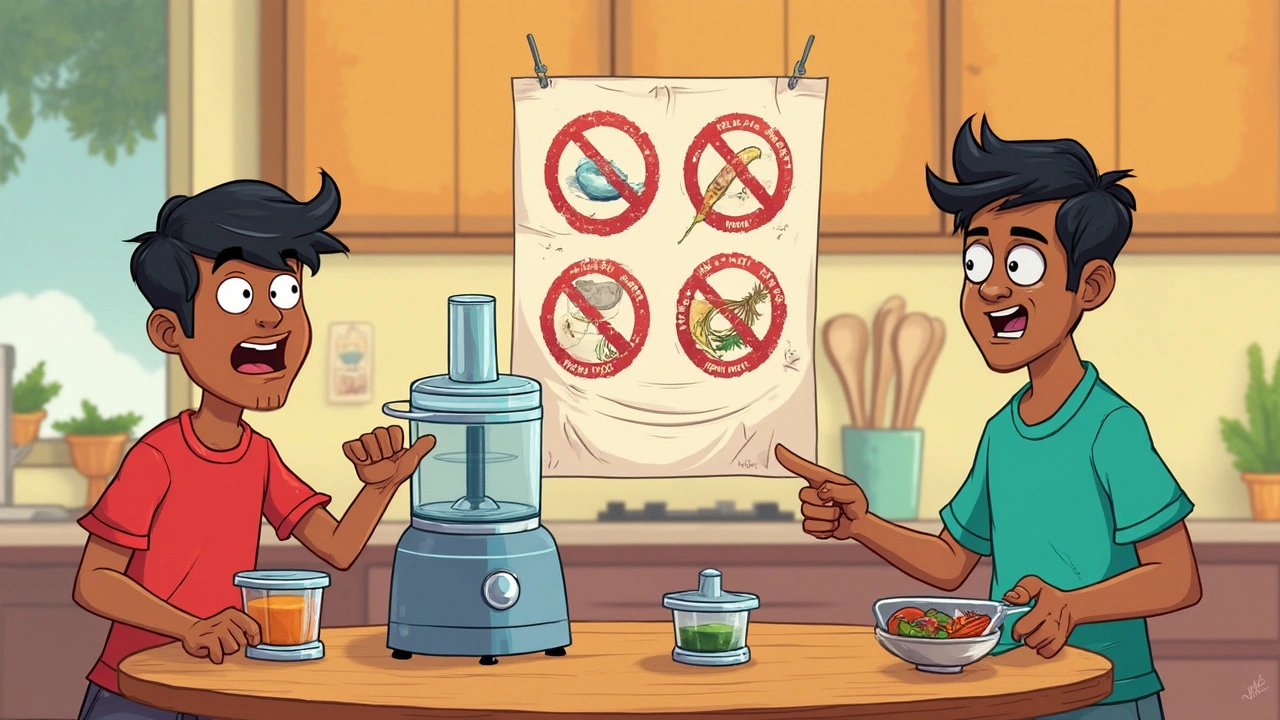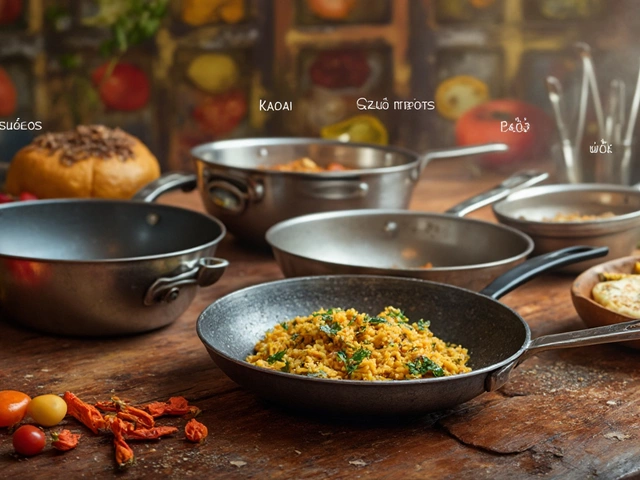
Ever thrown something in your food processor and watched the whole thing go sideways? It’s tempting to believe this gadget can chop, blend, or mash just about anything. But there are foods that simply don’t play nice with those spinning blades or the motor underneath.
If you want your food processor to last longer and save yourself the nightmare of cleaning sticky residue out of every nook and cranny, you’ll need to know what doesn’t belong inside. Certain foods might seem harmless but can end up dulling your blades, jamming the machine, or even burning out the motor.
Surprised? It happens more often than you’d think. People often toss in everything from raw potatoes to dried fruit, only to learn the hard way that some foods are just a recipe for disaster when processed this way. Stick around—knowing what to avoid could make meal prep way easier and keep your machine running for years.
- Why Some Foods Don't Belong in a Food Processor
- Hard Foods That Can Wreck Your Blades
- Sticky or Gooey Foods: Clogs and Clean-Up Nightmares
- Foods That Leave You With Bad Texture
- Liquid Overload: Splashes and Spills
- Non-Food Items: Common Kitchen Fails
Why Some Foods Don't Belong in a Food Processor
Lumping everything into your food processor isn’t just risky for the food—it can mess up your whole machine. Some foods are so tough or fibrous they can actually chip blades or stall the motor. Then you’ve got stuff that’s sticky or gooey, just waiting to glue itself inside, making cleanup a real pain. And it’s not just about the mess or damage. Some foods process so poorly in this unit that you’ll end up with bad texture, weird flavors, or totally ruined results.
Here’s what actually happens when you process the wrong food:
- Hard things like bones or raw sweet potatoes can snap blades or burn out the motor fast.
- Sticky foods like dried fruit or nut butters can ball up, clog the works, and get stuck behind the blade assembly.
- Huge amounts of liquid turn your food processor into a mini fountain. The bowl isn’t made for blending big batches of soup or thin batters—stuff leaks out the top or splashes everywhere.
- Leafy greens, if you add a ton at once, end up chopped unevenly or turn to mush instead of that nice, even blend you want.
- Fibrous veggies like celery can wrap around moving parts, making the whole thing jam up.
In a survey run by a popular home appliance brand in 2023, the top complaints about food processors included jammed blades (32%), leaks (25%), and poor mixing (19%).
| Common Problems | % of Users Reporting |
|---|---|
| Jammed Blades | 32% |
| Bowl Leaks | 25% |
| Uneven Mix | 19% |
If you want yours to last, stick to foods you know it can handle. It’s not just about saving your gear—it’s about getting food that actually tastes and looks good.
Hard Foods That Can Wreck Your Blades
This is where your food processor really meets its match. You’d be surprised how many folks have ruined good kitchen gear by dropping the wrong hard foods inside. Think you can save time by dicing raw sweet potatoes or whole coffee beans in your processor? Not a good plan. These foods can dull or even snap the blades, and sometimes the motor just burns out trying to keep up.
Here’s a no-go list that can save your machine:
- Raw root vegetables: Carrots, beets, sweet potatoes, and especially unpeeled or large chunks can be too tough for the blades. Either grate them first or cook them until soft. Letting the food processor handle them raw is asking for trouble.
- Hard cheese (like aged Parmesan): Unless your machine specifically says it’s built for it, stay away. Grating this kind of cheese in a processor puts way too much strain on the mechanism.
- Whole spices or coffee beans: These are for grinders, not your food processor. The blades just aren’t sharp or tough enough, and you’ll end up with uneven bits and a sad, rattling sound.
- Ice cubes or frozen foods: Throwing ice in might seem smart when you want shaved ice or to chill a sauce, but processors often can’t handle the rock-hard texture. Leave that for a blender meant for crushing ice.
- Bones or hard shells: Trying to break down leftover chicken bones or shellfish shells seems like a shortcut, but always results in a broken blade or worse, a total motor crash.
Just how much damage can these foods do? Here’s a quick breakdown from a recent survey on kitchen appliance repairs:
| Item Processed | % of Reported Blade/Motor Breakage |
|---|---|
| Raw Root Veggies | 41% |
| Hard Cheese | 22% |
| Coffee Beans | 19% |
| Ice Cubes | 13% |
| Bones/Shells | 5% |
The take-home message? Don’t think of your food processor as a superhero. Treat it with respect, keep really stubborn foods out of it, and you’ll save money on repairs (and avoid embarrassing emergency calls to the manufacturer).
Sticky or Gooey Foods: Clogs and Clean-Up Nightmares
Ever tried to process a big ball of dried fruit, super ripe bananas, or sticky nut butters? If yes, you probably know what a headache it is when sticky foods get jammed in your food processor. The blades stop spinning, the motor whines, and suddenly your kitchen adventure turns into a cleaning project.
Sticky and gooey foods—think dates, raisins, marshmallows, thick peanut butter, or melted cheese—can pile onto the blades and bowl. This does more than just slow things down. It can overheat the motor or, worse, break parts of the machine. "Machines like the food processor are designed for flow, not for stick," says kitchen gear specialist Claire Lower from Lifehacker.
Sticky foods tend to gum up the works and make both cleaning and processing a total pain.
Here’s why these kinds of foods don’t play nice:
- Sticky foods form clumps that keep blades from working properly.
- Goo can sneak into seals and motor parts—goodbye, easy appliance care.
- Cleanup gets brutal—especially with ingredients that set like glue as they dry.
If you can’t resist making energy bites or nut butters, try these hacks to keep your food processor happy:
- Chop dried fruit, chocolate, or similar things by hand first, then pulse with other ingredients.
- Add a splash of oil or warm water to loosen up stickier mixtures.
- Don’t overload! Work in small batches and scrape down the sides often.
- If you’re stuck, unplug and scoop out as much as you can—never force the blades or lid.
Just look at what most people fight with:
| Sticky Food | Problem | Simple Fix |
|---|---|---|
| Dates/Raisins | Gums up blades, forms paste | Chop finely, mix with dry foods |
| Nut Butters | Sticks to sides, clogs motor | Add oil, use small amounts |
| Melted Cheese | Melts, then solidifies inside bowl | Chill cheese slightly before processing |
So, before you toss a glob of caramel or a fistful of dried apricots into your machine, pause and think if it’ll be worth the clean-up. Your food safety and sanity will thank you.

Foods That Leave You With Bad Texture
Thinking about tossing eggs, potatoes, or leafy greens into your food processor? Hold up a sec. This is where many people run into big mistakes. Certain foods just end up mushy, slimy, or straight-up weird when processed the wrong way.
Potatoes are the classic example. Once you run raw potatoes through a food processor, you get a gluey mess. That’s because the sharp blades release too much starch, turning your spuds into a gummy paste instead of fluffy hash browns or fries. Use a grater for better results, or dice them by hand.
Want chopped hard-boiled eggs for egg salad? You don’t need a food processor—it’ll make them rubbery and overly minced. Fork or knife is the way to go if you want that good texture.
Here are a few more foods that usually come out wrong:
- Leafy greens: If you toss spinach or herbs into the food processor, you often get a watery, bruised pile instead of crisp chopped pieces. The heat from the motor plus those fast-spinning blades break the greens down too much.
- Tomatoes: You might want chopped tomatoes in a salsa, but a food processor often turns them straight into soup. All the juice just leaks out, leaving you with a watery mixture.
- Cheese (soft types): Soft cheeses like fresh mozzarella or Brie turn into a sticky mess that gums up the blades. For cheese, stick to firm varieties and freeze them briefly if they get sticky.
- Overripe fruit: Bananas, peaches, or other very ripe fruit can become puree in seconds—good for smoothies, terrible for fruit salads.
Got something you want chunky, not pulverized? A food processor isn’t always the right tool. Sometimes, good old-fashioned chopping actually gives you better results and the texture your dish deserves.
Check out this quick look at what happens to common foods when you try to process them:
| Food | Result |
|---|---|
| Raw potatoes | Gummy, gluey paste |
| Leafy greens | Wet, bruised mush |
| Soft cheese | Sticky blob, blade jams |
| Tomatoes | Watery puree, lost texture |
| Overripe fruit | Puree instead of chunks |
Remember, when you care about how your meal looks and feels, using your food processor for everything can backfire. When in doubt, try a test chop, or just reach for the knife.
Liquid Overload: Splashes and Spills
Think your food processor can work like a blender? That’s a classic mistake. These machines just aren’t built for a bunch of liquid. The seals around the bowl aren’t watertight, and most lids have some kind of opening where splashes can escape. Go overboard, and you’ll end up with a kitchen mess—and probably a puddle under your machine.
Most food processors can handle small amounts—think a couple of tablespoons or enough to moisten dough. But fill the bowl past the “max fill” line with soup, broth, or juice? Trouble. Not only does it leak, but all that liquid can slip into the motor below, leading to a short-circuit or a busted machine.
Here’s where people get tripped up the most:
- Trying to make smoothies or shakes. These are jobs for a blender, not a food processor, since processors can’t spin liquid mixtures fast or evenly.
- Blending hot soups. Hot liquids build steam, and pressure pops lids open. You might get burned or coat your wall with soup.
- Pureeing watery fruits or veggies on high speed. Juice can sneak right out of the bowl’s cracks and seams.
A lot of food processors have a “max liquid fill” line. Ignore it, and you’ll regret it. If yours doesn’t, keep the liquid under halfway full, just to be safe. Looking for actual numbers? On average, most food processors' bowls hold between 2 and 4 cups of liquid before risking leaks. Check your user manual for details.
It’s not all bad news, though. You can still make sauces, dips, or wet batters. Just add the liquids slowly, or mix them with the dry ingredients until things come together. If you need a thinner result, transfer your mixture to a blender or finish with a whisk. Here’s a quick comparison for typical kitchen appliances:
| Appliance | Best for Liquid? | Liquid Limit (Average) |
|---|---|---|
| Food Processor | No (use sparingly) | 2-4 cups |
| Blender | Yes | 6-8 cups |
| Stand Mixer | Sometimes | 4-8 cups |
Small tip: If you want to add a splash of olive oil or vinegar to a dip, use the feed tube with the machine running, not all at once. That way, your food processor won’t freak out, and you’ll keep everything where it belongs—inside the bowl.
Non-Food Items: Common Kitchen Fails
Sometimes kitchen chaos hits when you least expect it. Maybe you’re in a rush or not focused, and oops—you drop a spoon, a twist tie, or a stray bit of plastic wrap right into your food processor bowl. It’s easy to think the blades will chew through anything, but non-food items in your food processor are a one-way ticket to disaster.
Here’s what happens when something that’s not food gets caught in the works: you’ll almost always mess up the sharp edge of your blades, or even worse, jam and break your food processing unit. Let’s not forget, even a tiny piece of plastic or metal can shatter into smaller bits, ending up in your next meal—a nightmare for both safety and the taste of your dish.
The most common non-food mistakes people make in their kitchen include:
- Utensils: Spoons, spatulas, or whisks accidentally left inside the bowl or slipped in while scraping the sides. Metal will chip the blade. Even silicone or plastic can cause trouble.
- Twist ties and clips: Used to close bags of nuts or chips, but if you forget to remove them, those little bits of wire or plastic can do real damage to the motor and blade.
- Produce stickers: Leaving a sticker on your fruit or veggie is more common than you think. Once processed, the sticky part gums up the blades, and you’ll find tiny bits stuck in your finished food.
- Packaging bits: Pieces of hard plastic, cardboard or foil from packaging sometimes get mixed in with the ingredients.
- Cupboard debris: If you’re pulling ingredients from the back of the cupboard, dust, dried rice, or scraps can end up in your bowl. They add grit to whatever you’re prepping.
Even top brands like Cuisinart and KitchenAid report customer service calls every month about broken blades thanks to stray silverware or plastic. According to a recent appliance repair survey, nearly 12% of food processor repairs are linked to non-food items—mostly utensils that slipped in during use.
| Common Non-Food Fail | Result |
|---|---|
| Spoon left in bowl | Bent or chipped blades |
| Produce sticker | Sticky residue, food contamination |
| Twist tie | Blade jamming, possible motor burnout |
| Plastic wrap | Wraps around blade, tough to clean |
What’s the fix? Easy—build a quick habit: double-check your ingredients before loading them up, and always clear out any packaging, stickers, or ties. And watch out for sneaky utensils. A two-second scan saves you a world of stress and helps your food processor last much longer.




